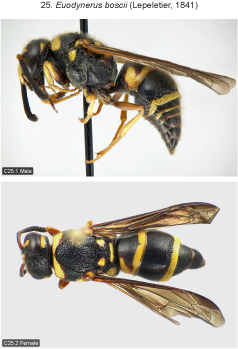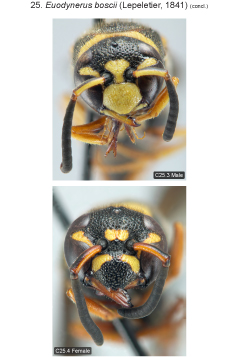
| Home | Table of contents | Keys | Species list | Glossary | Image data | PDF | Cite this article | Feedback | Updates |
Identification Atlas of the Vespidae (Hymenoptera, Aculeata) of the northeastern Nearctic region
CJAI 05, February 19, 2008
doi: 10.3752/cjai.2008.05
Matthias Buck, Stephen A. Marshall, and David K.B. Cheung
Department of Environmental Biology, University of Guelph, Guelph, Ontario, Canada N1G 2W1
Next species | Previous species | Key
25. Euodynerus boscii (Lepeletier, 1841)
Figs B5.19, 54; C25.1–4.

|

|
Species recognition. Euodynerus boscii is readily recognised by the well developed submarginal carina of the propodeum in combination with a conspicuously haired metasomal tergum 1. In other species with well developed submarginal carina the posterior horizontal portion of tergum 1 is bare. The male of E. boscii is furthermore characterized by the presence of a low ventral swelling on the basal half of the fore femur (a similar but less developed swelling is present in males of the extralimital E. pratensis).
Variation. Fore wing length ca. 8.5 mm (♂♂), ca. 10 mm (♀♀). Variation not studied.
Distribution. Not recorded from Canada. Eastern U.S. west to KS, OK, TX (Krombein 1979). The northern limit of the distribution of E. boscii is not explicitly mentioned in the literature. Bohart and Menke (1974) mention it from MD, which appears to be the northernmost record. The northeastern subspecies is molestus (de Saussure, 1870). The nominate subspecies occurs from NC to northern FL; ssp. boharti (Krombein, 1959) is restricted to Florida.
Biology. Nests in borings in wood including structural lumber. Cell partitions and terminal plug are made of firmly agglutinated sand. Prey are caterpillars of Crambidae (Pyraustinae) and Pyralidae (Epipaschiinae) (Krombein 1967, 1979).
Next species | Previous species | Key
| Home | Table of contents | Keys | Species list | Glossary | Image data | PDF | Cite this article | Feedback | Updates |
